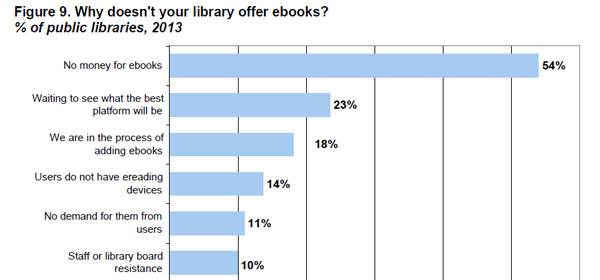
Last week, we highlighted some of Pew Internet’s recent findings on Americans’ reading habits, including trends in e-book reading and tablet usage. For the library perspective, Library Journal offers an annual survey on how e-books are being used and adopted in U.S. public libraries. In its fourth year, the 2013 survey includes data from more than 500 libraries about e-book circulation, collection, and acquisition.
Generally, e-book demand has eased off and collections are more stable, all while circulation continues to grow. Of those libraries surveyed, nearly 9 of 10 (89%) libraries offer e-books—the same as in 2012—and a quarter of those who don’t offer e-books planned to start in the upcoming year. Median e-book collection size continues to grow, rising from 5,080 in 2012 to 7,380 in 2013. Median circulation more than doubled from 2012, and it surpassed the 12,000 mark in 2013. This despite that 91% of public libraries’ e-book titles are lent using a one-title/one-user model and the average holds-to-copy ratio was 6 to 1.
As is to be expected, respondents reported the major barriers to e-book usage were limited numbers of e-books and availability of popular titles. And the public is still having trouble making the e-book checkout process work: More than 2 in 5 (43%) respondents said they heard patrons ask for help downloading e-books on their devices every day. Resources to purchase e-books are also limited, but libraries seem to be making do, whether by reallocating funds from elsewhere in the materials budget or looking to consortia for help.
Read the full report, available for download courtesy of Library Journal, to learn out more about how public libraries are handling everything from device lending programs to purchasing terms. And check out statistics on e-books in Colorado’s public libraries through our interactive data tool at http://www.lrs.org/public/data/basic/.
Note: This post is part of our series, “The Weekly Number.” In this series, we highlight statistics that help tell the story of the 21st-century library.